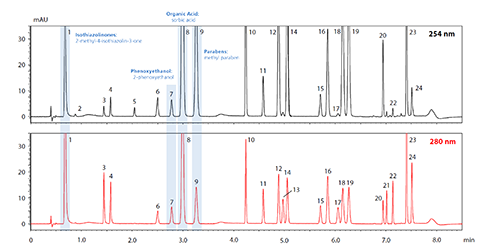This application note describes a technique to detect and quantify 24 commonly found preservatives in cosmetics in under 8 minutes and explains how a change in LC columns can achieve both high-resolution and high-speed analysis of preservatives.
 Preservatives are commonly added to cosmetics to increase their shelf life and prevent the growth of bacteria and mold. Common antiseptic compounds such as parabens and phenoxyethanols are often used for this purpose, however, these added preservatives are known to cause allergic symptoms (e.g. eczema and dermatitis) in humans. Strict regulations on the type and quantity of preservatives in cosmetics have been imposed in various countries such as Japan and Europe.
Preservatives are commonly added to cosmetics to increase their shelf life and prevent the growth of bacteria and mold. Common antiseptic compounds such as parabens and phenoxyethanols are often used for this purpose, however, these added preservatives are known to cause allergic symptoms (e.g. eczema and dermatitis) in humans. Strict regulations on the type and quantity of preservatives in cosmetics have been imposed in various countries such as Japan and Europe.
This article features the high-resolution and high-speed analysis of 24 cosmetic preservatives using Shimadzu’s Nexera series UHPLC system and Shim-pack Velox C18 Superficially Porous Particles (SPP) core shell column. All 24 preservatives (including parabens, phenoxyethanol, organic acids and isothiazolinones) were separated and detected in under 8 minutes. Furthermore, the described UHPLC method successfully quantified these preservatives in commercially available lotions.

Chromatograms of 24 Cosmetic Preservative Standard Solutions.
Download this application note...
- Detect and quantify 24 commonly found preservatives in cosmetics in under 8 minutes
- Understand how a change in LC columns could achieve both high-resolution and high-speed analysis of preservatives.




